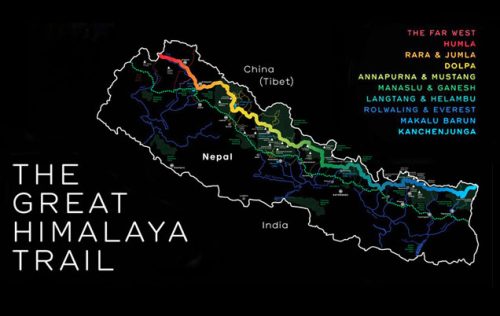Introduction:
Nepal, a landlocked country lies in south Asia at the lap of central Himalayas. Himalayan ranges start from the Indus River in the west and end at the Bramhaputra River in the east covering Afghanistan, Pakistan, India, Nepal and Bhutan. The Bay of Bengal of Indian Ocean is the nearest sea to Nepal. Its distance is 550 km from Jhapa to the Bay of Bengal. The nearest other countries from Jhapa of Nepal are Bangladesh (27 km) and Bhutan (32km).
Official name:
Federal Democratic Republic of Nepal
Location:
Latitude: 26° 22' North - 30° 27' North Latitude (read as 26 degrees 22 minute)
Longitude: 80° 4' East - 88° 12' East Longitude
Nepal Standard Time (NST) is based on the Longitude on Gauri-Shankar Himal.
Extent of Nepal:
Nepal Area: 147,181 sq. Km (0.03% of the total land population of the world)
World Area: 510,000,000 sq. Km
Nepal is 1/3004 parts of the world. There are more than 100 countries smaller than Nepal and almost 100 countries bigger than Nepal. So Nepal is a medium-sized country in the world.
Dimensions
Length: Approx. 885 km from east to west
Width: Approx. 193 km from North to South
Boundary: North - China (65 times bigger than Nepal, population - 136 Crore and Per Capita Income (PCI) - USD 7000)
East, west & south - India (22 times bigger than Nepal, population - 125 Crore and Per Capita Income (PCI) - USD 1500)
Nepal's PCI is USD 717
Physical features of Nepal:
Nepal is a mountainous country as the majority of its land is covered with hills and mountains.
76% - high mountains and hills including limited areas of valleys, Tars, Besi etc.
24% - Low-level land (terai) and inner terai
Nepal's land topography ranges from 60m (Kechana of Jhapa) - 8848m (Sagarmatha).
Based on topographic altitude Nepal can be divided into
A. The Himalayan Region (3000-8848m)
Elevation: 3000-8848m
Length: 885km
Width: 24-50 km
Area: 25% of Nepal
16 districts of Nepal lie in the Himalayan region. 6% of Nepal's land is situated above snowline (5000m). The snow line is that line where snow remains throughout the year and the field above it is known as snowfield. Manang, Mustang, Humla, Jumla, and Darchula lie beyond the Himalayas so they don't work as a border. Our mountains are gaining a height of 1.27cm/year.
The Himalayan region can be sub-divided into 3 regions
i) The Greater Himalaya
The Greater Himalaya is also known as Mahalangur Himal is a section of the Himalayas in northeast Nepal and south-central Tibet extending east from the pass Nangpa La between Rolwaling Himal and Cho Oyu, to the Arun River. It includes Mount Everest (8848m), Lhotse (8516m), Makalu (8463m), and Cho Oyu (8201m) — four of Earth's six highest peaks. There are more than two dozen mountain series in this region. On the Tibetan side, it is drained by the Rongbuk and Kangshung Glaciers and on the Nepali side by Barun, Ngojumba and Khumbu Glaciers and others. All are tributaries to the Koshi River via Arun River on the north and east or Dudh Kosi on the south.
ii) The Border or Trans Himalaya
The Himalaya between Trishuli in the east to Humla Karnali in the west and lies on the border of China and Nepal is known as Trans Himalaya. It is 30-450 km away from the Greater Himalayas. It is smaller than the Greater Himalayas (5000-7000m). There is less snow so these are deserted and barren. It is also known as the cold desert mountain region. It shares a border with China. Names of the border Himalayas from west towards east are Nalakankad, Changla, Gorkha, Kanti, Gautam, Mustang Bhotay, Damodar, Peri etc.
iii) The Inner Himalaya
Inner Himalaya is also known as High Mountain Valley. It is known as the Bhote of Nepal. It lies between 2400-5000m and 8/12 months remain very cold. There is not much rainfall in this area so less fertile but abundant in herbs like Yarshagumba, Jatamashi, Panchaule etc. The people of this region are very rich because of tourism and herbs.
# Pass (bhanjyang) from east to west
- Tipta La pass (5055m) of Olangchung Gola
- Popti La Pass (4195m) at Kimathanka of Sankhuwasabha
- Kodari Pass (1677m) of Sindhupalchowk is the lowest pass
- Rasuwagadi Pass (1829m) used to work as the main trade route during the Malla period between China, Tibet, Nepal & India. Chinese call it Kerung
- Tinkar Pass (4258m) of Mahakali Zone
These five passes are open for the people of both countries, legally. Apart from these, there are several other passes which are used by the local people showing the identification card.
B. The Hilly Region
Elevations: 600-3000m
Length: 885 km
Width: 75-125 km
Area: 50% of Nepal
Districts: 39
Sub-division of Hilly Region
a) The midland
i. Valleys
Largest valley - Kathmandu 6685 sq. km
The watershed area of the Bagmati River
Altitude: 1350m
Second largest valley - Pokhara
ii. Tar
The biggest Tar of Nepal is Salyantar of Dhading
iii. Besi
b) The Mahabharat Range (middle Himalaya):
It is also called the Lesser Himalaya – is a major east-west mountain range with elevations 3,700 to 4,500 m (12,000 to 14,500 feet) along the crest, paralleling the much higher Great Himalaya range from the Indus River in Pakistan across northern India, Nepal, Sikkim and Bhutan but then the two ranges become increasingly difficult to differentiate east of Bhutan as the ranges approach the Brahmaputra River. The Mahabharat range also parallels the lower Shivalik or Churia Range (Outer Himalaya) to the south. Lies between the north and south of Nepal. Eg. Shivapuri, Chandragiri, Phulchowki, Nagarjun, Ghyampedada etc. Three rivers Karnali, Saptagandaki & Saptakoshi have intersected Mahabharat Range and flow to India through Chisapani, Devghat & Barah Kshetra respectively.
c) Churia Range:
It is also known as Outer Himalaya by the geologists. It is the youngest and lowest range and lies in the southernmost of Nepal. The highest altitude in Churia is Garba Hill (1872m).
C. The Terai Region
i) Inner Terai - 7% of the total land of Nepal
ii) Bhabar Region - 4% of the total land of Nepal
Charkoshe Jhadi of width 13 Km lies in this region
iii) The southern Terai Belt - 13% of the total land of Nepal
# Rivers, Lakes & waterfalls of Nepal
http://yatrama.blogspot.com/
No. of rivers: 6000 (length 45,000km)
Volume of water: 200-250 billion cubic meters
Hydroelectric: Theoretical potentiality - 83,000 MW
Economical potentiality - 42,000 MW
Infrastructure for electricity
Developed: 750 MW
Supply: 400-500 MW
Demanded: 1100-1200 MW
Nepal's rivers can be classified into 3 parts
1) Rivers of the first grade
Water source: The mountains of Nepal & Tibet flow from North to south.
Eg. From east towards west Saptakoshi, Saptagandaki, Karnali & Mahakali
Tributaries of Saptakoshi
-Tamor (Originated from Janak himal, Kanchanjunga himal, Kumbek himal etc.)
-Arun (Originated from Tibet and travels 500 km to reach Nepal and enters from Snkhuwasabha. Length in Nepal is 168km.)
-Dudhkoshi (Originated from Solukhumbu's Mahalangur Himal; Dudhkoshi meets Sunkoshi and becomes Sunkoshi)
-Likhu (Originated from Ramechhap and meets at Sunkoshi)
-Tamakoshi (Originated from Tibet and enters Nepal from Upper Tamakoshi 465MW is being under construction)
-Sunkoshi (Its main sub River is Bhotekoshi originating from Tibet and enters Nepal from Kodari pass)
-Indrawati (Originated from Jugal Himal and Panchpokhari)
Saptakoshi flows to Ganga through Bhagalpur. It is the biggest river.
Tributaries of Saptagandaki
- Trishuli (This is the main sub-river, originated from Bhotekoshi of Rasuwa. It meets Langtang Khola and Chilime Khola during its journey.)
- Budi Gandaki (Originated from Tibet, enters Nepal from Manaslu and meets Trishuli at Benighat. Consultation on the Benighat hydro project is going on)
- Daraundi (Originated from Boudha himal of Gorkha, meets Marshyangdi at Abukhaireni and further meets Trishuli at Muglin)
- Marshyangdi (Originated from Peri Himal, Damodar Himal, Tilicho Lake, meets Trishuli at Muglin)
- Madi (Originated from Annapurna 2nd, Annapurna 4th and flows to meet seti at.......
- Seti (Originated from Annapurna 3rd, Machhapuchhre Himal and flows through Kaski district and flows to meet Gaighat ( between Muglin and Devghat) and becomes Trishuli)
- Kaligandaki (Originated from Mustang Bhote himal, Kaagbeni River, Ridi and meets Trishuli at Devighat and becomes Narayani River.)
It enters India through Bhaisalotan and is known as Gandak in India, further, it flows through Hajipur and enters in Ganga. Saptagandaki is Nepal's 2nd largest River
Tributaries of Karnali
Humla Karnali
Mugu Karnali
Tila river
Paschim seti
Budi Ganga
Thuli bheri
Sani bheri
All these rivers meet at different places flow through Chisapani and enter India through Kalarniyaghat. It is the 3rd largest River of Nepal. Its total length in Nepal is 507 km so becomes the longest river of Nepal. Karnali holds a capacity of 10800 MW of hydroelectricity and is best for irrigation.
Mahakali
Originated from the mountains of Darchula and the mountains of India and entered Nepal
Tributaries
Chameliya
Surnayagadh
Mahakali Sandhi 20 yrs ago
Pancheshwor's capacity: 6840 MW
India and Nepal agreed to invest 63% and 37% respectively to utilize 50-50% of electricity generated
The ratio of water that flows in these rivers is 1:10 in the dry and rainy seasons respectively.
2) Rivers of the second grade (source: rainfall at Mahabharata Range)
Rivers from east to west with origin
Mechi - Ilam
Kankai - Ilam
Trijuga- Udayapur
Kamala - Sindhuli
Bagmati - Shivapuri
Tinau - Palpa
Rapti - Pyuthan
Babai - Salyan
The ratio of water that flows in these rivers is 1:100 in the dry and rainy seasons respectively.
3) Rivers of the third grade (Source: Churia)
Helps in the storage of water in the terai, hence making the land fertile.
Lakes of Nepal
Nepalese lakes are divided into three parts based on structure
- Glacial lakes of the Himalayan region (हिमताल)
Eg. Chho-Rolpa. There are more than 2300 glacial lakes and out of them 2 dozens are about to burst
- Tectonic lakes of the Hilly region (भौगोलिक हलचलवाट वनेको ताल)
Kathmandu was also a lake some 31,000 years ago. It became a lake because of the tectonic movements.
- Ox-bow lakes of the Terai region (गोरू जुरे ताल)
Lakes created by the meandering rivers (नागवेली खोला)
Largest lake: Rara (Mugu) - area 11 sq. Km
Deepest lake: Phoksundo (Dolpa) - depth 650m
Highest altitude: Tilicho (manang) - altitude 4919m
Largest manmade lake: Indrasarovar (Makawanpur)
Waterfalls
Highest waterfall: Suligadh (length 167m) of Dolpa at 3613m
Tallest waterfall: Hyatung of Terathum (length 365m)
Beautiful waterfall: Ruptse of Myagdi as it falls making a cascade.
# Climate and natural vegetation
Nepal's climate is a Subtropical monsoon climate. There are twelve types of climates in the world. One of them is the Subtropical Monsoon Climate. This climate prevails at 23.5° degree - 35° latitude. It changes its direction and behaviour as per the season
During winter the wind blows from land to sea
During summer the wind blows from sea to land
This region (from Pakistan to Japan) is also called monsoon Asia. Nepal's climate changes not only as per the subtropical region but also differs due to topographical setting. Nepalgunj (152m) and Namchhebazzar (3450m) lie on the same latitude but they have different climate because of altitudinal variation.
Factors affecting the climate of Nepal
a] Altitude temperature decreases with increasing altitude at the lapse rate of 6°- 6.5°c.
5060m - 0° C
4060m - 6° C Mountain
3060m - 12° C
2060m - 18° C
1060m - 24° C Hilly
60m - 30° C Terai
Everest region is called the third pole because it remains below 0° C, always
b] Distance from the sea
Parts that are near the sea get more rainfall than the farther regions
Closer the sea, equable climate; farther the sea, extreme climate
Eg. Delhi gets colder in winter and gets hotter in summer, whereas Jhapa has a moderate climate during the summer and winter.
c] Directions and slope of the mountain
The slope of the mountain causes low and high of high rainfall.
Northern slopes receive less rainfall and western slopes receive high rainfall.
Pokhara and Jomsom lie in the south and north of the Annapurna receive high and less rainfall respectively








